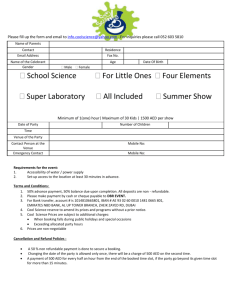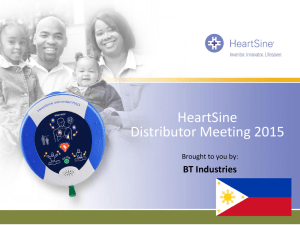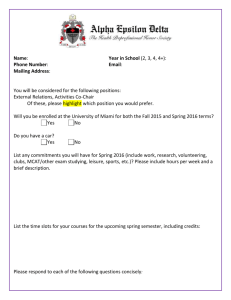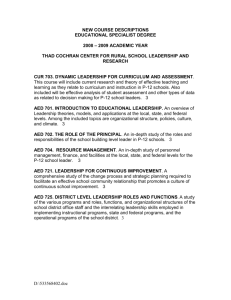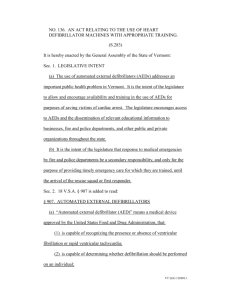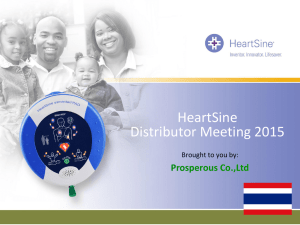(AED) For Sports Clubs
advertisement
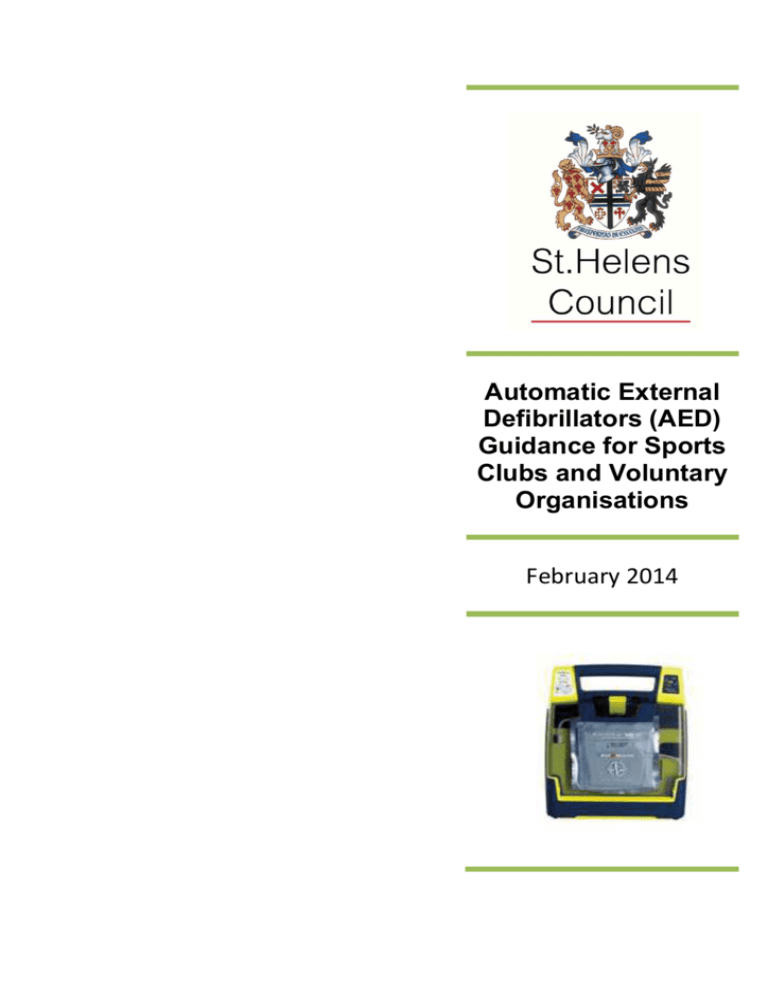
Automatic External Defibrillators (AED) Guidance for Sports Clubs and Voluntary Organisations February 2014 Automatic External Defibrillators (AED) Guidance for Sports Clubs and Voluntary Organisations 1.0 Purpose 1.1 This guidance document will guide Sports Clubs and Voluntary Groups in the discussion surrounding the decision to install an AED. Furthermore, it will provide context to the requirements and resource implications for the effective installation and use of an AED in your setting. 2.0 Introduction 2.1 The sudden death of child is a devastating event and whilst a rare occurrence, the tragic deaths of a small number of children locally from cardiac related conditions has led to local charities advocating and fund raising for defibrillators. A number of local schools and sports clubs have already utilised fund raising activity to purchase and install defibrillators on their sites 2.2 A decision about the installation of defibrillators on a site is a matter for the Organisations Management Committee to determine. The Local Authority has no powers to compel organisations to install such equipment. 2.3 However, a number of community groups and local sports clubs have already purchased defibrillators. This guidance has been developed to support those that wish to purchase and utilise defibrillators within their organisation or facility. 3.0 Background 3.1 AEDs are used to help resuscitate people who have had a cardiac arrest. The process of defibrillation is conducted with limited need for intervention from the operator. Only two arrhythmias are likely to respond to such treatment; there are other arrhythmias (not all life threatening), which will not respond to electric shock. 3.2 Defibrillators are compact, lightweight and durable. Modern defibrillators test themselves daily and will both sound and display a warning if there is a fault with the device. However, simple daily visual checks are recommended and systems must be in place to ensure the recording of these checks. 3.3 AEDs are intrinsically safe to use, can be used by anyone and do not present a risk of harm to individuals. However, it is recommended that people undertake some awareness training to increase the speed of treatment, increase confidence and improve the effectiveness of cardiopulmonary resuscitation (CPR) treatment. Studies have found that: • • • • Only 15% of cardiac arrests occur in public 37% of cardiac arrests are the type that respond to AEDs Recovery following the use of an AED ranges from 5% to 39% Children experience fewer cardiac arrests than adults From the point a person collapses to the delivery of the first shock is the single most important determinant of survival. The Resuscitation Council states that for every minute that passes without defibrillation the chances of survival decreases by 10%. 3.4 The British Heart Foundation and North West Ambulance Service (NWAS) place defibrillators in suitable public locations with high footfall and easy accessibility, and these are assessed on a case-by-case basis. This is a guidance document produced by St.Helens Council to support Sports Clubs and Voluntary Organisations Issued: February 2014 Automatic External Defibrillators (AED) Guidance for Sports Clubs and Voluntary Organisations Please note, it is important to inform NWAS if you choose to purchase any defibrillators so they can put the location on their system. 4.0 Legal position 4.1 There is no legal obligation (statute or civil) to provide AEDs. However, once an AED is provided on a site, the organisation may owe a duty of care to a victim. Civil liability would only arise if a person’s injuries or outcome were made worse – for example CPR was delayed unnecessarily because the AED was missing, not maintained, or was situated too far from the point of the incident. Additionally, it is an absolute duty that any AED must be maintained in a safe condition under the Provision and Use of Work Equipment Regulations 1998. 5.0 Specification and Purchasing 5.1 There are a wide variety of AEDs available for purchase, ranging from about £650 to £2,500 plus VAT. There are costs for consumable items such as the defibrillator pads and batteries, which the device supplier will be able to confirm with you. 5.2 Clubs and Organisations are free to select and procure their own AED. However, it is recommended that they contact NWAS for further guidance regarding the purchase of an AED and in the case of Sports Clubs their National Governing Body of Sport. 5.3 Standard AED pads are suitable for use in children older than 8 years. Special Paediatric pads, that attenuate the current delivered during defibrillation, should be purchased for use on Children 1 – 8 years of age. However, adult pads can be used in an emergency and should remain connected to the device. 6.0 Location and Access 6.1 The locations of the AEDs should be carefully considered at the planning stage. You will need to ensure that all parts of the site are within a reasonable distance of an AED. When planning the location(s), you should consider: • Distance. For an AED to be effective, it needs to be available for use within two to three minutes. You will need to consider how quickly a rescuer will be able to make the return journey from the injured person, to the AED, and back, whilst still being able to administer CPR and operate the AED. • Risks to the rescuer. It may not be appropriate to require a rescuer to run up or down stairs, and certainly not more than one flight of stairs. • Outside activities. Where sports fields etc are some distance from club house / building, you will need to consider arrangements to ensure that an AED remains available within the required timescale. • Procedure. As discussed later in this guidance, a procedure for a suspected cardiac arrest should be developed. This should be considered at an early stage, as this may affect the suitability of AED locations. • Seperate Venues – in the case of clubs who use multiple venues clubs should give consideration to making an AED available at all sites. • Storage – if stored outside AED’s should be kept in a cabinet with an alarm. This is a guidance document produced by St.Helens Council to support Sports Clubs and Voluntary Organisations Issued: February 2014 Automatic External Defibrillators (AED) Guidance for Sports Clubs and Voluntary Organisations 6.2 AEDs should be provided with adequate signage to ensure they are easily recognised. Either the UK standard sign or the International Liaison Committee on Resuscitation sign is acceptable; however a consistent sign should be used across the site. These can be obtained from the Resuscitation Council or from the British Heart Foundation. 6.3 Devices should be adequately installed with the appropriate wall bracket. 6.4 If the site is in use the AED must be accessible and a trained individual in attendance 7.0 Equipment checks 7.1 All AEDs should be subject to daily visual checks to ensure that they are available for use in the designated position. This task should be clearly assigned in writing to a person, and may form part of the normal site opening procedure. Checks should be recorded at the end of each week as being completed stating any faults found and consumable expiry dates. 7.2 There is a model AED Checklist available on the Sports Development pages of the Council’s Website 7.3 The manufacturer’s instructions should be followed in relation to any additional routine checks required. 8.0 Procedure in the event of a suspected cardiac arrest 8.1 The first aid procedures for the site be revised, and the action to be taken in the event of a suspected cardiac arrest should be appended to that procedure. A simple flowchart may be all that is required. This should include: • Who will do what? • Communication. How will the alarm be raised? Who will make the call to 999 • How will the AED be brought to the injured person? Will the first rescuer on the scene obtain this after calling for assistance? If there is a permanently manned reception on a small site, will they take the AED to the rescuer after calling 999, so that the rescuer can administer CPR in the interim period? 8.2 The final procedure should be tested to ensure it is practical, and then communicated to all relevant staff. 9.0 Training 9.1 Training is not essential for a member of the public to use an AED – they are designed to be simple to operate, with diagrams and often voice prompts on what action to take. However, in a club environment, it is prudent for some members to be trained in the use of AEDs to ensure they are used in an effective and efficient manner. 9.2 Some suppliers will deliver some initial training included within the price of the AED; others may charge for this. Clubs and Organisations should consider how external trainers would be selected. 9.3 St Helens Council offers training on the use of AEDs with basic CPR. This is a guidance document produced by St.Helens Council to support Sports Clubs and Voluntary Organisations Issued: February 2014 Automatic External Defibrillators (AED) Guidance for Sports Clubs and Voluntary Organisations 9.4 There should be two elements to the training – instructing staff on how to use the AEDs, and notifying staff of the local procedure and locations of the devices. The training requirements should be included in the local first aid procedure document. 9.5 The more people that receive training, the more likely it is that an AED will be used and operated efficiently should it be required. A club or organisation may chose to train those who have received Emergency First Aid training. At least one trained operator should be on site at all times. 9.6 As with all training, periodic refresher training is required to retain the skills and knowledge required to operate an AED effectively. Annual intervals are recommended although this is not a legal requirement. 10.0 Education 10.1 It is important to acknowledge that the installation of an AED is just one link in the Chain of Survival and that educating people in emergency life support (ELS) is equally as important. 11.0 Informing your statutory Ambulance Service 11.1 North West Ambulance Service can advise on all aspects of this document, and can (subject to availability) visit your site. Please email camcrtinterests@nwas.nhs.uk with your request, or contact 0151 260 5220 and asked to be connected to the Community Resuscitation Team. 11.2 Informing the Ambulance Service of a defibrillator and location can assist if someone suffers a Cardiac Arrest within very close proximity of the site. An example of this would be where someone suffers a Cardiac Arrest in a vehicle directly outside of the site. When 999 is called, the Emergency Services have a record of the location of the defibrillator and will direct the caller to this venue. 12.0 Useful Contacts Rob Sharples Community Resusitation Team North West Ambulance Service (NWAS) Tel: 0151 2612604. Email: robert.sharples@nwas.nhs.uk John Lynch First Aid Lead Tutor Community and Adult Learning – St.Helens Council Tel: 01744 677327 Email: johnlynch@Sthelens.gov.uk This is a guidance document produced by St.Helens Council to support Sports Clubs and Voluntary Organisations Issued: February 2014 Automatic External Defibrillators (AED) Guidance for Sports Clubs and Voluntary Organisations Appendix 1 Frequently Asked Questions on Defibrillation and Defibrillators What does AED stand for? • Automated external defibrillator. What is an AED? • An AED is a device that is used to shock a person in cardiac arrest. They are designed to establish the rhythm and if identified as shockable – these will administer a shock to stun the heart and try to establish the natural pacemaker. What is Public access defibrillation (PAD)? • Public access defibrillation (PAD) is the term used to describe the use of AEDs by anyone anywhere. Much higher survival rates have been recorded in cases where an AED was brought to the scene quickly and used without delay. Do I have to have an AED in my workplace? Is it law that you have to have an AED at work? Why should I have an AED in my workplace? • There is currently no legal requirement to have an AED. However, if your normal first aid needs risk assessment identifies people may be at risk (e.g. ageing workforce, high volumes or staff undertaking physical work,) then an AED may be appropriate. Are AEDs easy to use? • Yes. After turning on the AED (some turn on automatically when opened), the user is guided at every step by voice prompts and a visual display. Do I have to be trained to use an AED? • If an AED is situated in the workplace, people must be trained in its use as it is then classed as workplace equipment. However, in an emergency, the UK Resuscitation Council states that untrained bystanders should not be discouraged from using the device. They are simple to use and cannot do any harm to the casualty. Can AEDs be used on children as well as adults? • Yes, standard AED are suitable for use on children older than 8 years. Can an AED be used when it is wet or raining? • Yes. The AED operator may need to dry the casualty’s chest to ensure that the AED electrodes stick well and ensure a good electrical contact. • Can an AED be used on a pregnant woman? • Yes. The most important thing to do is assist the mother as the child will not survive otherwise. Has anyone been sued in the UK for using an AED on a casualty who did not recover? • To date, no one in the UK, USA or Australia has been successfully sued for using an AED on a person in cardiac arrest and failing to revive them. What if I use an AED and make things worse by shocking someone that does not need shocking? • It is impossible to shock someone that does not require it. An AED cannot make the situation worse or allow a shock to be given to a healthy person. Are AEDs dangerous unless used by a medical professional? • No. An AED is designed to be simple to use. This is a guidance document produced by St.Helens Council to support Sports Clubs and Voluntary Organisations Issued: February 2014 Automatic External Defibrillators (AED) Guidance for Sports Clubs and Voluntary Organisations Should an AED be kept in a locked cabinet? • Bringing an AED to the casualty as quickly as possible is the priority – so the AED should be readily available. However, alarmed cabinets may be advisable for locations where security is an issue. What is the difference between a heart attack and cardiac arrest? • Normally, a person having a heart attack is conscious and their heart is working well enough at that moment to sustain life. A person in cardiac arrest is unconscious and their heart isn’t working effectively or at all. Their breathing maybe absent or abnormal. Could I kill someone if I try to use an AED? • No. A person in cardiac arrest is already clinically dead. Early cardiopulmonary resuscitation (CPR) and early use of an AED can significantly increase their chances of survival; the instigation of this sequence of events is known as the ‘chain of survival’. An AED will not allow a shock to be given to someone unless they are in cardiac arrest. FAQs - Kindly provided by North West Ambulance Service This is a guidance document produced by St.Helens Council to support Sports Clubs and Voluntary Organisations Issued: February 2014 Automatic External Defibrillators (AED) Guidance for Sports Clubs and Voluntary Organisations Appendix 2 Checklist for the installation of AEDs Initial considerations Have you considered your own local needs? Have you consulted with staff, parents/carers and the governing body? What basic first aid provision do you currently have in place? Have you researched whether there are any AEDs within the immediate proximity? Have you contacted NWAS or your NGB to seek their guidance on purchasing a device? Have you researched the cost and supplier of an AED? Will training be provided as part of the purchase costs? Installing the AED Have you considered the location(s) of the AEDs? Who will be responsible for the daily checks? Who will be responsible for recording the weekly checks? Who will be responsible for the on-going maintenance of the device? Who will be responsible for administering the device should an incident occur? Which members of staff will undergo training? Who will deliver the training? Do you have both children and adult ‘pads’? Managing the AED Have you informed NWAS that your site has an AED? Is the location of the AED clearly signposted? Is it placed in an accessible location? How will you monitor the maintenance of the AED? How do you ensure that an adequate number of people are trained at any one time? This is a guidance document produced by St.Helens Council to support Sports Clubs and Voluntary Organisations Issued: February 2014
